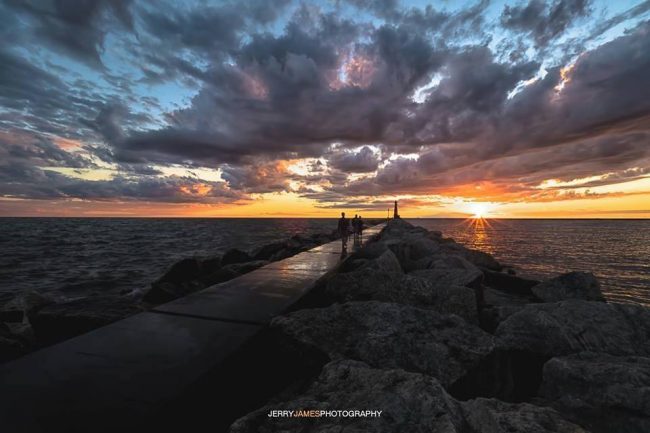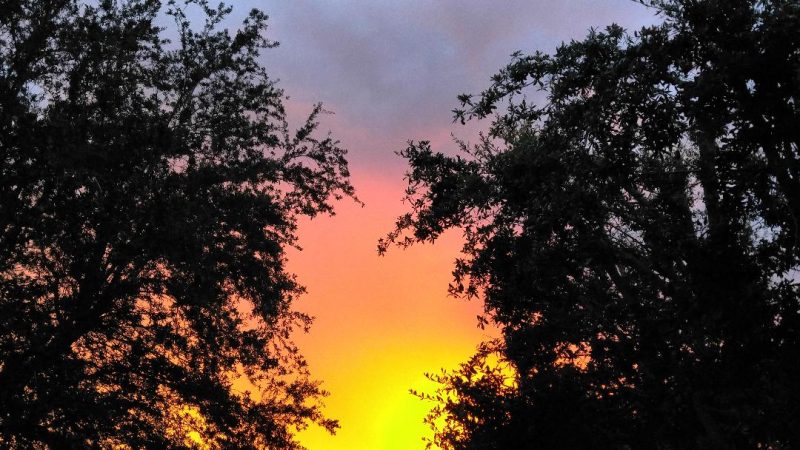
Image at top: Peter Gipson in Stowmarket, Suffolk, England, captured this June sunset, complete with a sun pillar. Thanks, Peter! Submit your image to EarthSky here.
For people living around 40 degrees north latitude, the latest sunset of the year happens on or near June 27. And in the Southern Hemisphere, at 40 degrees south latitude, it’s the year’s latest sunrise that happens around now. That’s in spite of the fact that the Northern Hemisphere’s longest (or Southern Hemisphere’s shortest) day of the year fell on the June 20 solstice.
The year’s latest sunset always comes after the summer solstice, even though the exact date of the latest sunset depends on your latitude. Farther north – at Seattle – the latest sunset happened around June 25. Farther south – at Mexico City or Hawaii – the latest sunset won’t happen until early July.
Want to know your date of latest sunset? Try this custom sunrise/sunset calendar.

June sunset – Pere Marquette Beach in Muskegon, Michigan – via Jerry James Photography. Thank you, Jerry!
The latest sunset comes after the summer solstice because the day is more than 24 hours long at this time of the year.
For several weeks, around the June solstice, the day (as measured by successive returns of the midday sun) is nearly 1/4 minute longer than 24 hours. Hence, the midday sun (solar noon) comes later by the clock in late June than it does on the June solstice. Therefore, the sunrise and sunset times also come later by the clock, as the table below helps to explain.
For Denver, Colorado
| Date | Sunrise | Midday (Solar Noon) | Sunset | Daylight Hours |
| June 20 | 5:32 a.m. | 1:01 p.m. | 8:31 p.m. | 14h 59m 15s |
| June 27 | 5:33 a.m. | 1:03 p.m. | 8:32 p.m. | 14h 57m 50s |
Source: timeanddate.com

Juan Argudin in Pembroke Pines, Florida, wrote on June 21, 2018: “We’ve taken dozens of sunset pictures but cannot remember such beautiful sunset colors. This was the first sunset after summer solstice, taken between 2 live oak trees in front of our house. Thank you for your excellent newsletter. We have learned a lot.” Photo by Olga Argudin. Thank you, Juan and Olga!
If the Earth’s axis stood upright as our world circled the sun, and if, in addition, the Earth stayed the same distance from the sun all year long, then clock time and sun time would always agree. However, the Earth’s axis is titled 23.44 degrees out of vertical, and our distance from the sun varies by about 3 million miles (5 million km) throughout the year. At and around the equinoxes, solar days are shorter than 24 hours, yet at the solstices, solar days are longer than 24 hours.
The latest sunset always comes on or near June 27 at mid-northern latitudes every year.
At mid-northern latitudes, the later clock time for solar noon one week after the summer solstice is more substantial than the change in daylight hours. Given that the daylight hours today (June 27) are almost the same as they were a week ago (on the June 20th solstice), the later clock time for today’s solar noon gives us slightly later sunrise and sunset times, as well
Bottom line: Why don’t the latest sunsets come on the longest day (the solstice)? In a nutshell, it’s a discrepancy between the sun and the clock. Thus, for mid-northern latitudes, the latest sunsets always come in late June.
Enjoying EarthSky so far? Sign up for our free daily newsletter
Donate: Your support means the world to us
from EarthSky https://ift.tt/2KHCZSn

Image at top: Peter Gipson in Stowmarket, Suffolk, England, captured this June sunset, complete with a sun pillar. Thanks, Peter! Submit your image to EarthSky here.
For people living around 40 degrees north latitude, the latest sunset of the year happens on or near June 27. And in the Southern Hemisphere, at 40 degrees south latitude, it’s the year’s latest sunrise that happens around now. That’s in spite of the fact that the Northern Hemisphere’s longest (or Southern Hemisphere’s shortest) day of the year fell on the June 20 solstice.
The year’s latest sunset always comes after the summer solstice, even though the exact date of the latest sunset depends on your latitude. Farther north – at Seattle – the latest sunset happened around June 25. Farther south – at Mexico City or Hawaii – the latest sunset won’t happen until early July.
Want to know your date of latest sunset? Try this custom sunrise/sunset calendar.

June sunset – Pere Marquette Beach in Muskegon, Michigan – via Jerry James Photography. Thank you, Jerry!
The latest sunset comes after the summer solstice because the day is more than 24 hours long at this time of the year.
For several weeks, around the June solstice, the day (as measured by successive returns of the midday sun) is nearly 1/4 minute longer than 24 hours. Hence, the midday sun (solar noon) comes later by the clock in late June than it does on the June solstice. Therefore, the sunrise and sunset times also come later by the clock, as the table below helps to explain.
For Denver, Colorado
| Date | Sunrise | Midday (Solar Noon) | Sunset | Daylight Hours |
| June 20 | 5:32 a.m. | 1:01 p.m. | 8:31 p.m. | 14h 59m 15s |
| June 27 | 5:33 a.m. | 1:03 p.m. | 8:32 p.m. | 14h 57m 50s |
Source: timeanddate.com

Juan Argudin in Pembroke Pines, Florida, wrote on June 21, 2018: “We’ve taken dozens of sunset pictures but cannot remember such beautiful sunset colors. This was the first sunset after summer solstice, taken between 2 live oak trees in front of our house. Thank you for your excellent newsletter. We have learned a lot.” Photo by Olga Argudin. Thank you, Juan and Olga!
If the Earth’s axis stood upright as our world circled the sun, and if, in addition, the Earth stayed the same distance from the sun all year long, then clock time and sun time would always agree. However, the Earth’s axis is titled 23.44 degrees out of vertical, and our distance from the sun varies by about 3 million miles (5 million km) throughout the year. At and around the equinoxes, solar days are shorter than 24 hours, yet at the solstices, solar days are longer than 24 hours.
The latest sunset always comes on or near June 27 at mid-northern latitudes every year.
At mid-northern latitudes, the later clock time for solar noon one week after the summer solstice is more substantial than the change in daylight hours. Given that the daylight hours today (June 27) are almost the same as they were a week ago (on the June 20th solstice), the later clock time for today’s solar noon gives us slightly later sunrise and sunset times, as well
Bottom line: Why don’t the latest sunsets come on the longest day (the solstice)? In a nutshell, it’s a discrepancy between the sun and the clock. Thus, for mid-northern latitudes, the latest sunsets always come in late June.
Enjoying EarthSky so far? Sign up for our free daily newsletter
Donate: Your support means the world to us
from EarthSky https://ift.tt/2KHCZSn

Aucun commentaire:
Enregistrer un commentaire